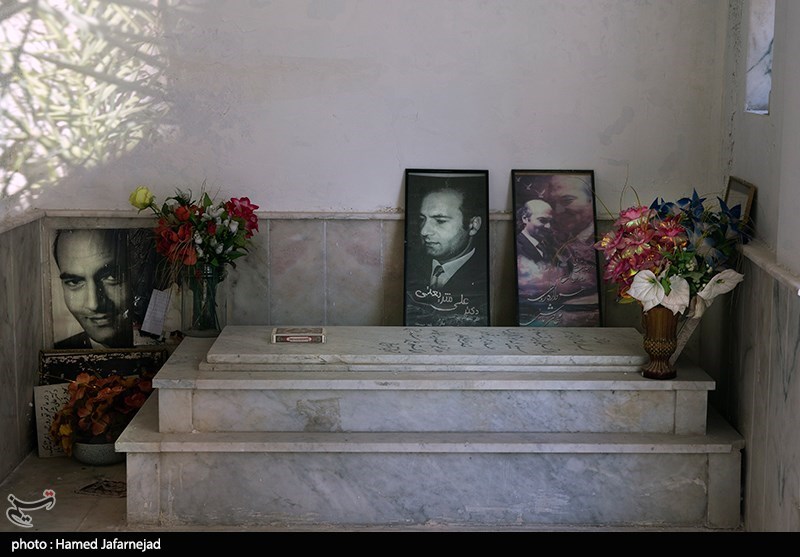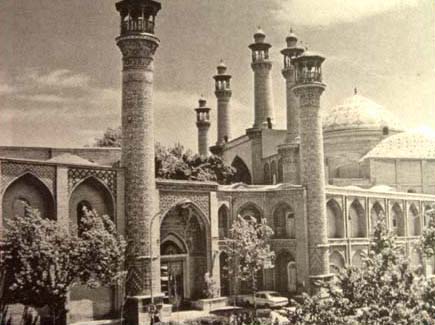|
Ayatollah Mahmoud Taleghani
Sayyid Mahmoud Alaee Taleghani ( fa, محمود طالقانی, , also Romanized as Seyed Mahmūd Tāleqānī; 5 March 1911 – 9 September 1979) was an Iranian theologian, Muslim reformer, democracy advocate and a senior Shi'a Islamic Scholar and thinker of Iran. Taleghani was a contemporary of the Iranian Revolutionary leader Ayatollah Ruhollah Khomeini and a leader in his own right of the movement against Shah Mohammad Reza Pahlavi. A founding member of the Freedom Movement of Iran, he has been described as a representative of the tendency of many "Shia clerics to blend Shia with Marxist ideals in order to compete with leftist movements for youthful supporters" during the 1960s and 1970s. His "greatest influence" has been said to have been in "his teaching of Quranic exegesis," as many later revolutionaries were his students.Bakhash, Shaul, ''Reign of the Ayatollahs'' (1984), p. 168 He was notably Tehran's first Friday Prayer Imam after the Iranian Revolution. Biography and ... [...More Info...] [...Related Items...] OR: [Wikipedia] [Google] [Baidu] |
Galird, Alborz
Geliyard ( fa, گِليَرد, also Romanized as Gelīyard) is a village in Bala Taleqan Rural District, in the Central District of Taleqan County, Alborz Province, Iran. At the 2006 census, its population was 232, in 42 families. The village is the birthplace of Ayatollah Mahmoud Taleghani. Etymology The word ''Geliyard'' or ''Giliyard'' derives from Gil, which is the name of an ancient ethnicity in Medes united confederation, and were the ancestors af today Gilaks. The ''-ard'' also is the suffix of location which means milieu or territory, and derives from the Avestan Avestan (), or historically Zend, is an umbrella term for two Old Iranian languages: Old Avestan (spoken in the 2nd millennium BCE) and Younger Avestan (spoken in the 1st millennium BCE). They are known only from their conjoined use as the scrip ... word of ''Ard'' which means land. Hence Geliyard means land of Gil people. References Populated places in Taleqan County {{Taleqan-geo-stub ... [...More Info...] [...Related Items...] OR: [Wikipedia] [Google] [Baidu] |
Twelver
Twelver Shīʿīsm ( ar, ٱثْنَا عَشَرِيَّة; '), also known as Imāmīyyah ( ar, إِمَامِيَّة), is the largest branch of Shīʿa Islam, comprising about 85 percent of all Shīʿa Muslims. The term ''Twelver'' refers to its adherents' belief in twelve divinely ordained leaders, known as the Twelve Imams, and their belief that the last Imam, Imam al-Mahdi, lives in Occultation and will reappear as ''The promised Mahdi'' ( ar, المهدي المنتظر). According to the Shīʿa tradition, the Mahdi's tenure will coincide with the Second Coming of Jesus (ʿĪsā), who, along with Mahdi, would kill the Dajjal. Twelvers believe that the Twelve Imams are the spiritual and political successors to the Islamic prophet Muhammad. According to the theology of Twelvers, the Twelve Imams are exemplary human individuals who not only rule over the Muslim community (''Ummah'') with justice, but are also able to preserve and interpret the Islamic law (''sharīʿa'' ... [...More Info...] [...Related Items...] OR: [Wikipedia] [Google] [Baidu] |
Iranian Peoples
The Iranian peoples or Iranic peoples are a diverse grouping of Indo-European peoples who are identified by their usage of the Iranian languages and other cultural similarities. The Proto-Iranians are believed to have emerged as a separate branch of the Indo-Iranians in Central Asia around the mid-2nd millennium BC. At their peak of expansion in the mid-1st millennium BC, the territory of the Iranian peoples stretched across the entire Eurasian Steppe, from the Great Hungarian Plain in the west to the Ordos Plateau in the east and the Iranian Plateau in the south.: "From the first millennium b.c., we have abundant historical, archaeological and linguistic sources for the location of the territory inhabited by the Iranian peoples. In this period the territory of the northern Iranians, they being equestrian nomads, extended over the whole zone of the steppes and the wooded steppes and even the semi-deserts from the Great Hungarian Plain to the Ordos in northern China." The ... [...More Info...] [...Related Items...] OR: [Wikipedia] [Google] [Baidu] |
Romanization
Romanization or romanisation, in linguistics, is the conversion of text from a different writing system to the Roman (Latin) script, or a system for doing so. Methods of romanization include transliteration, for representing written text, and transcription, for representing the spoken word, and combinations of both. Transcription methods can be subdivided into ''phonemic transcription'', which records the phonemes or units of semantic meaning in speech, and more strict ''phonetic transcription'', which records speech sounds with precision. Methods There are many consistent or standardized romanization systems. They can be classified by their characteristics. A particular system’s characteristics may make it better-suited for various, sometimes contradictory applications, including document retrieval, linguistic analysis, easy readability, faithful representation of pronunciation. * Source, or donor language – A system may be tailored to romanize text from a particular lan ... [...More Info...] [...Related Items...] OR: [Wikipedia] [Google] [Baidu] |
Muhammad Abduh
; "The Theology of Unity") , alma_mater = Al-Azhar University , office1 = Grand Mufti of Egypt , term1 = 1899 – 1905 , Sufi_order = Shadhiliyya , disciple_of = , awards = , influences = Jamal ad-Din al-Afghani, Ibn Sina, Ibn 'Arabi, Shihāb al-Din Sührawardį, Abu Hamīd al-Ghāzāli, Abu al-Mānsūr al-Matūrīdī, Hasan al-Attar, Rifa'a al-Tahtawi, Gustave Le Bon, Herbert Spencer , influenced = Rashid Rida, Abul Kalam Azad, Hassan al-Banna, Sayyid Qutb, Muhammad Asad, Mahmoud Taleghani, Muhammad al-Tahir ibn Ashur, Mahmud Shaltut, Mustafa al-Maraghi, Mohammed al-Ghazali, Yusuf al-Qaradawi , module = , website = Muḥammad ʿAbduh (1849 – 11 July 1905) (also spelled Mohammed Abduh, ar, محمد عبده) was an Egyptian Islamic scholar, journalist, teacher, author, editor, judge, and Grand Mufti of Egypt. He was a central figure of the Arab Nahḍa and Islami ... [...More Info...] [...Related Items...] OR: [Wikipedia] [Google] [Baidu] |
Muhammad Husayn Tabataba'i
Muhammad Husayn Tabataba'i or Sayyid Mohammad Hossein Tabataba'i (16 March 1903 – 15 November 1981) was an Iranian scholar, theorist, philosopher and one of the most prominent thinkers of modern Shia Islam. He is perhaps best known for his ''Tafsir al-Mizan'', a twenty-seven-volume work of tafsir (Quranic exegesis), which he produced between 1954 and 1972. He is commonly known as Allameh Tabataba'i and the Allameh Tabataba'i University in Tehran is named after him. Biography He received his earlier education in his native Tabriz city, mastering the elements of Arabic and the religious sciences, and at about the age of twenty set out for the great Shiite university of Najaf to continue more advanced studies. He studied at Najaf, under masters such as Ali Tabatabaei (in gnosis), Mirza Muhammad Husain Na'ini, Sheykh Muhammad Hossein Qaravi Esfahani (in Fiqh and Jurisprudence), Sayyid Abu'l-Qasim Khwansari (in Mathematics), as well as studying the standard texts of Avicenna's ''S ... [...More Info...] [...Related Items...] OR: [Wikipedia] [Google] [Baidu] |
Azam Taleghani
Azam Taleghani ( fa, اعظم طالقانی; 1943 – 30 October 2019) was an Iranian politician and journalist who was the head of the Society of Islamic Revolution Women of Iran, editor of ''Payam-e-Hajar'' weekly, and a member of the Iranian parliament.فرخزاد، پوران (Pooran Farrokhzad). کارنمای زنان کارای ایران (از دیروز تا امروز). تهران: نشر قطره، ۱۳۸۱، ، 533. Early life Born in Iran, Taleghani was the daughter of Ayatollah Mahmoud Taleghani. She served time in prison during the Pahlavi regime. After the Iranian Revolution she was a member of the Iranian parliament, founded "Jame'e Zanan Mosalman" (Society of Muslim women), and published ''Payam e Hajar'' Weekly, an Islamic journal about women and women's rights. In 2003 she protested against the death of Zahra Kazemi. Both in 2001 and 2009, Taleghani submitted her candidacy for Iran's presidential elections, but, like all women's candidacies, her candidac ... [...More Info...] [...Related Items...] OR: [Wikipedia] [Google] [Baidu] |
Ali Shariati
Ali Shariati Mazinani ( fa, علی شریعتی مزینانی, 23 November 1933 – 18 June 1977) was an Iranian revolutionary and sociologist who focused on the sociology of religion. He is held as one of the most influential Iranian intellectuals of the 20th century and has been called the "ideologue of the Iranian Revolution", although his ideas did not end up forming the basis of the Islamic Republic. Biography Ali Shariati (Ali Masharati) was born in 1933 in Mazinan, a suburb of Sabzevar, in northeastern Iran. His father's family were clerics. His father, Mohammad-Taqi, was a teacher and Islamic scholar. In 1947, he opened the Centre for the Propagation of Islamic Truths in Mashhad, in Khorasan Province. It was a social Islamic forum which became embroiled in the oil nationalisation movement of the 1950s. Shariati's mother was from a small land-owning family. His mother was from Sabzevar, a little town near Mashhad. In his years at the Teacher's Training College in M ... [...More Info...] [...Related Items...] OR: [Wikipedia] [Google] [Baidu] |
Sepahsalar Mosque
The Sepahsālār Mosque ( fa, مسجد سپهسالار - ''Masjed-e Sepahsālār'') is a famous historic mosque in Tehran, Iran. The construction project of the mosque was started in 1879 upon the order of Mirza Hosein Sepahsalar, the Grand Vizir of Iran during Naser al-Din Shah Qajar, and the first phase of construction was finished after five years since it was started. The mosque was renamed the Shahid Motahhari (), after the 1979 Iranian Revolution, but it is commonly known as its initial name of Sepahsalar Mosque. The Sepahsalar Mosque is one of the largest Mosque in Tehran. During the late Qajar as well as Pahlavi era, Sepahsalar mosque was distinctive landmark of Tehran with its eight minarets which was unique in Persian design of mosques. The mosque is located southeast of Baharestan square, next to the former National Consultative Majlis of Iran. Architecture The Sepahsalar Mosque is the first mosque in Tehran whose design is mix of Persian architecture and archit ... [...More Info...] [...Related Items...] OR: [Wikipedia] [Google] [Baidu] |
Feyziyeh School
Feyziyya School ( fa, مدرسه فیضیه) is an old school in Iran that was founded in the Safavid era. The school has been listed as one of Iran's national monuments as of January 29, 2008. The school served as a focal point for clerical opposition to Mohammad Reza Shah Pahlavi's White Revolution. In 1963 on Ashura, Ayatollah Ruhollah Khomeini delivered a speech at the school denouncing the Shah, and was arrested as a result. Background The Feyziyya School was founded in Qom during the Safavid era. An epigraph on the south veranda dates its construction to the reign of Shah Tahmasp. A school by the name of ''Astana'' existed at the site, from the 6th century until the 11th. Reconstruction was carried out under the Safavids and the school was renamed Feyziyya. The school was rebuilt and extended under Fath-Ali Shah in 1792. The school has 40 rooms on the first floor, 4 long veranda, 12 stalls and a square pool. History Opposition to the White Revolution In 1963 Moham ... [...More Info...] [...Related Items...] OR: [Wikipedia] [Google] [Baidu] |
Najaf Seminary
The Najaf Seminary ( ar, حوزة النجف), also known as the al-Hawza Al-Ilmiyya (الحوزة العلمية), is the oldest and one of the most important Shia seminaries (hawza) in the world. It is located in the city of Najaf in Iraq. The school also operates a campus in Karbala, Iraq. It is located near the Imam Ali Mosque. It was established in the 11th century by Grand Ayatollah Shaykh al-Tusi. History Shaykh Tusi went to Baghdad to continue education. After 12 years, he was forced to leave Baghdad and go to Najaf for sectarian differences. He established the seminary in Najaf in 430 AH (the 11th century AD), which continued as a center of study until the establishment of modern Iraq in 1921. He died in 460 AH (1067 CE). The seminar was one of the biggest and most important ''hawza'' of the world for educating and training Shia clerics. Subjects The subjects taught at the seminary include: * Mantiq (Logic) * Usul al-Fiqh (Principles of Jurisprudence) * Fiqh (Jurisprude ... [...More Info...] [...Related Items...] OR: [Wikipedia] [Google] [Baidu] |







